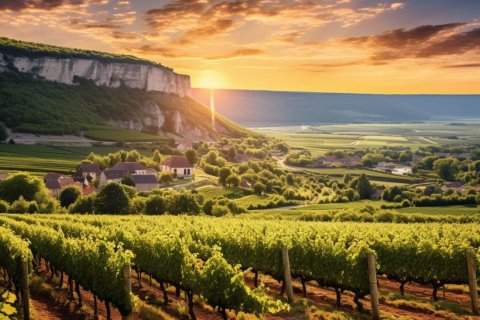The History of the Champagne Region
The Champagne region, located in northeastern France, is renowned worldwide for its exquisite sparkling wine. This region's rich history and secrets of champagne production have made it a symbol of luxury and celebration. Let's delve into the fascinating history and intricate process behind the creation of this iconic beverage.
Early Beginnings
The story of champagne dates back to ancient times when the Romans first cultivated vineyards in this region. However, the sparkling wine we know today began to take shape during the Middle Ages. It was monks in Champagne who made significant contributions to its development.
Monastic orders like the Benedictines and Cistercians refined winemaking techniques, including the blending of different grape varieties, to create a more palatable wine. They also introduced the use of cork stoppers, which were essential for retaining the wine's effervescence.
The Sparkling Discovery
In the 17th century, champagne's effervescence became a source of fascination and intrigue. The bottles used at the time were not strong enough to contain the pressure generated by the fermentation process, leading to the occasional explosion. This issue led to experimentation and the development of stronger glass bottles and cork closures, ultimately giving rise to the sparkling champagne we adore today.
Royal Approval
Champagne's popularity continued to grow, and it gained the favor of the French monarchy. Louis XIV declared it the only wine suitable for royalty. The association of champagne with nobility and luxury cemented its status as a symbol of celebration.
The Modern Era
Throughout the 19th and 20th centuries, champagne production saw significant advancements. The region's vineyards were classified, and the concept of terroir became central to champagne production. This classification system recognized the unique characteristics of different vineyard areas and their impact on the grapes.
Today, champagne is produced using a meticulous and regulated process that combines tradition with innovation. The region boasts a plethora of prestigious champagne houses, each with its own distinct style and history.
Secrets of Champagne Production
The production of champagne is a complex and highly regulated process that involves precise steps and techniques. Here are the key secrets behind champagne production:
Grape Selection
Champagne is typically made from a blend of three grape varieties: Chardonnay, Pinot Noir, and Pinot Meunier. The specific blend varies among producers and styles, with each grape contributing unique characteristics to the final product.
Pressing and Fermentation
The grapes are gently pressed to extract their juice, which is then fermented in stainless steel or oak tanks. The base wine is created through this initial fermentation.
Assemblage
Champagne houses excel in the art of assemblage, which involves blending wines from different vintages and vineyards to achieve the desired flavor profile. This skill is a closely guarded secret of each champagne producer.
Second Fermentation
After assemblage, the wine undergoes a second fermentation in the bottle. This is where the effervescence is created, as carbon dioxide is trapped in the sealed bottle, producing bubbles.
Aging
Champagne must be aged for a minimum period before it can be sold. Non-vintage champagne is aged for a minimum of 15 months, while vintage varieties must be aged for at least three years. Some prestige cuvées are aged for even longer, developing complex flavors and aromas.
Disgorgement and Dosage
Before final bottling, the sediment formed during the second fermentation is removed in a process called disgorgement. The champagne is then topped up with a mixture of wine and sugar, known as the dosage, to determine its sweetness level.
Final Corking and Labeling
Each bottle is sealed with a cork and wire cage to contain the carbonation. The label is affixed, indicating the producer, style, and vintage of the champagne.
Champagne's allure lies not only in its exquisite taste but also in the history and craftsmanship that go into its creation. It remains a symbol of celebration, a testament to the dedication and expertise of the Champagne region's winemakers.
FAQs
What makes champagne different from other sparkling wines?
Champagne is distinguished by its origin; it must be produced in the Champagne region of France. Additionally, it undergoes a specific production process, including a second fermentation in the bottle, which gives it its unique effervescence.
Why are there different sweetness levels in champagne?
Champagne can vary in sweetness, from bone-dry (Brut Nature) to very sweet (Demi-Sec). This variation is achieved by adjusting the dosage, a mixture of wine and sugar added before corking, to suit different taste preferences.
How should I store and serve champagne?
Champagne should be stored in a cool, dark place, away from direct sunlight and temperature fluctuations. When serving, chill the bottle to around 45-50°F (7-10°C), and use proper champagne flutes to preserve the bubbles and aromas.
What are some famous champagne houses?
Some renowned champagne houses include Dom Pérignon, Moët & Chandon, Veuve Clicquot, and Krug, among others. Each has its own history and signature style.



